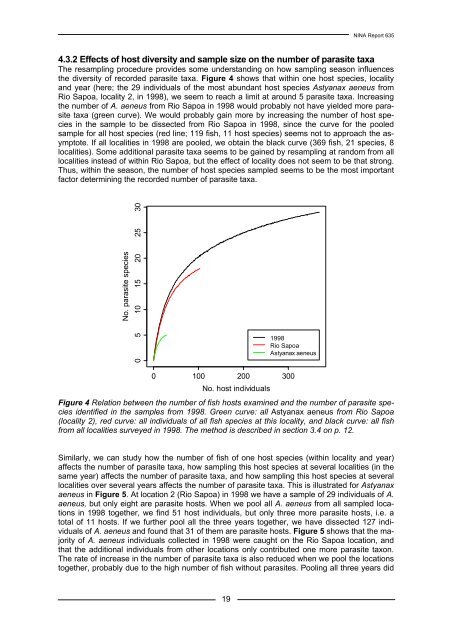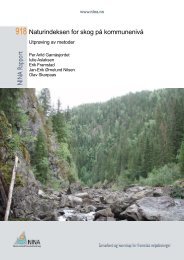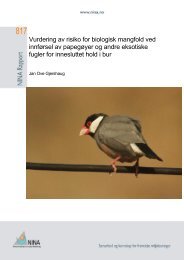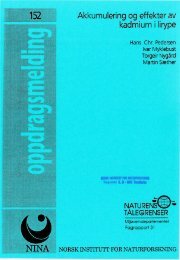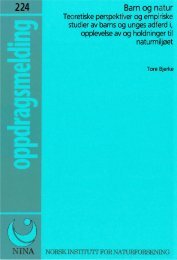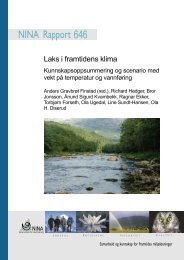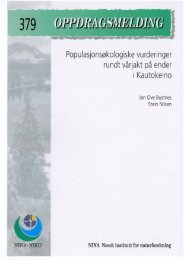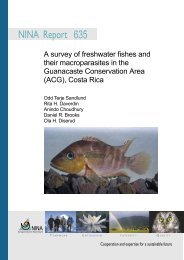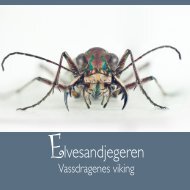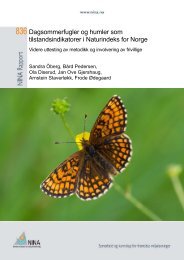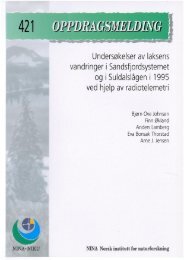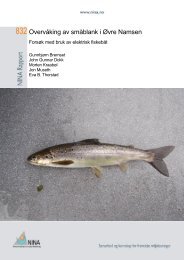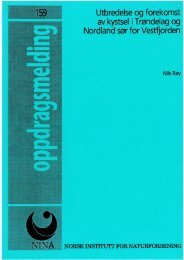A survey of freshwater fishes and their macroparasites in the ... - NINA
A survey of freshwater fishes and their macroparasites in the ... - NINA
A survey of freshwater fishes and their macroparasites in the ... - NINA
Create successful ePaper yourself
Turn your PDF publications into a flip-book with our unique Google optimized e-Paper software.
19<br />
<strong>NINA</strong> Report 635<br />
4.3.2 Effects <strong>of</strong> host diversity <strong>and</strong> sample size on <strong>the</strong> number <strong>of</strong> parasite taxa<br />
The resampl<strong>in</strong>g procedure provides some underst<strong>and</strong><strong>in</strong>g on how sampl<strong>in</strong>g season <strong>in</strong>fluences<br />
<strong>the</strong> diversity <strong>of</strong> recorded parasite taxa. Figure 4 shows that with<strong>in</strong> one host species, locality<br />
<strong>and</strong> year (here; <strong>the</strong> 29 <strong>in</strong>dividuals <strong>of</strong> <strong>the</strong> most abundant host species Astyanax aeneus from<br />
Rio Sapoa, locality 2, <strong>in</strong> 1998), we seem to reach a limit at around 5 parasite taxa. Increas<strong>in</strong>g<br />
<strong>the</strong> number <strong>of</strong> A. aeneus from Rio Sapoa <strong>in</strong> 1998 would probably not have yielded more parasite<br />
taxa (green curve). We would probably ga<strong>in</strong> more by <strong>in</strong>creas<strong>in</strong>g <strong>the</strong> number <strong>of</strong> host species<br />
<strong>in</strong> <strong>the</strong> sample to be dissected from Rio Sapoa <strong>in</strong> 1998, s<strong>in</strong>ce <strong>the</strong> curve for <strong>the</strong> pooled<br />
sample for all host species (red l<strong>in</strong>e; 119 fish, 11 host species) seems not to approach <strong>the</strong> asymptote.<br />
If all localities <strong>in</strong> 1998 are pooled, we obta<strong>in</strong> <strong>the</strong> black curve (369 fish, 21 species, 8<br />
localities). Some additional parasite taxa seems to be ga<strong>in</strong>ed by resampl<strong>in</strong>g at r<strong>and</strong>om from all<br />
localities <strong>in</strong>stead <strong>of</strong> with<strong>in</strong> Rio Sapoa, but <strong>the</strong> effect <strong>of</strong> locality does not seem to be that strong.<br />
Thus, with<strong>in</strong> <strong>the</strong> season, <strong>the</strong> number <strong>of</strong> host species sampled seems to be <strong>the</strong> most important<br />
factor determ<strong>in</strong><strong>in</strong>g <strong>the</strong> recorded number <strong>of</strong> parasite taxa.<br />
No. parasite species<br />
0 5 10 15 20 25 30<br />
0 100 200 300<br />
No. host <strong>in</strong>dividuals<br />
1998<br />
Rio Sapoa<br />
Astyanax aeneus<br />
Figure 4 Relation between <strong>the</strong> number <strong>of</strong> fish hosts exam<strong>in</strong>ed <strong>and</strong> <strong>the</strong> number <strong>of</strong> parasite species<br />
identified <strong>in</strong> <strong>the</strong> samples from 1998. Green curve: all Astyanax aeneus from Rio Sapoa<br />
(locality 2), red curve: all <strong>in</strong>dividuals <strong>of</strong> all fish species at this locality, <strong>and</strong> black curve: all fish<br />
from all localities <strong>survey</strong>ed <strong>in</strong> 1998. The method is described <strong>in</strong> section 3.4 on p. 12.<br />
Similarly, we can study how <strong>the</strong> number <strong>of</strong> fish <strong>of</strong> one host species (with<strong>in</strong> locality <strong>and</strong> year)<br />
affects <strong>the</strong> number <strong>of</strong> parasite taxa, how sampl<strong>in</strong>g this host species at several localities (<strong>in</strong> <strong>the</strong><br />
same year) affects <strong>the</strong> number <strong>of</strong> parasite taxa, <strong>and</strong> how sampl<strong>in</strong>g this host species at several<br />
localities over several years affects <strong>the</strong> number <strong>of</strong> parasite taxa. This is illustrated for Astyanax<br />
aeneus <strong>in</strong> Figure 5. At location 2 (Rio Sapoa) <strong>in</strong> 1998 we have a sample <strong>of</strong> 29 <strong>in</strong>dividuals <strong>of</strong> A.<br />
aeneus, but only eight are parasite hosts. When we pool all A. aeneus from all sampled locations<br />
<strong>in</strong> 1998 toge<strong>the</strong>r, we f<strong>in</strong>d 51 host <strong>in</strong>dividuals, but only three more parasite hosts, i.e. a<br />
total <strong>of</strong> 11 hosts. If we fur<strong>the</strong>r pool all <strong>the</strong> three years toge<strong>the</strong>r, we have dissected 127 <strong>in</strong>dividuals<br />
<strong>of</strong> A. aeneus <strong>and</strong> found that 31 <strong>of</strong> <strong>the</strong>m are parasite hosts. Figure 5 shows that <strong>the</strong> majority<br />
<strong>of</strong> A. aeneus <strong>in</strong>dividuals collected <strong>in</strong> 1998 were caught on <strong>the</strong> Rio Sapoa location, <strong>and</strong><br />
that <strong>the</strong> additional <strong>in</strong>dividuals from o<strong>the</strong>r locations only contributed one more parasite taxon.<br />
The rate <strong>of</strong> <strong>in</strong>crease <strong>in</strong> <strong>the</strong> number <strong>of</strong> parasite taxa is also reduced when we pool <strong>the</strong> locations<br />
toge<strong>the</strong>r, probably due to <strong>the</strong> high number <strong>of</strong> fish without parasites. Pool<strong>in</strong>g all three years did


